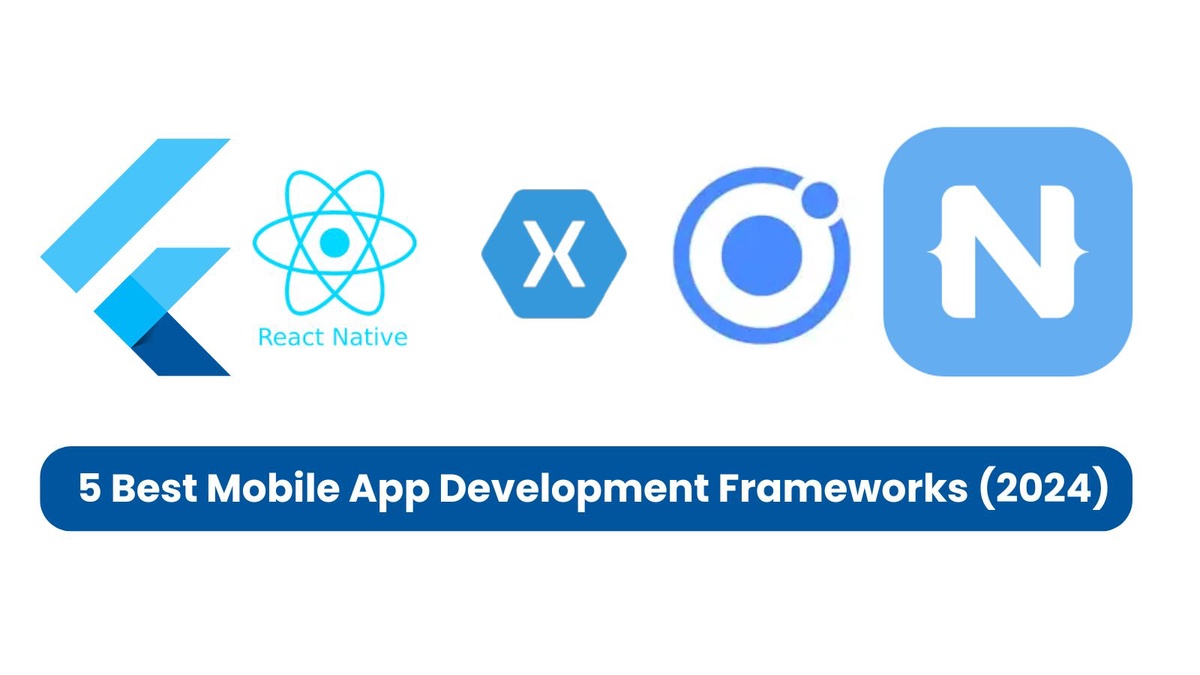In the ever-evolving landscape of mobile app development, making the right framework choice is a crucial decision that can significantly impact the success of your project. With a myriad of options available, it’s essential to evaluate the pros and cons of each mobile app development framework.
Here, we explore the top five mobile app development frameworks for 2024, helping you make an informed decision tailored to your specific needs.
5 Best Mobile App Development Frameworks (2024)
1) Flutter: Unleashing the Power of Dart
Pros of Flutter:
- Cross-Platform Development: Flutter allows developers to build cross-platform mobile applications with a single codebase. This is advantageous for companies looking to reach both Android and iOS users without maintaining separate codebases.
- Google’s Backing: Being developed by Google gives Flutter a level of credibility and support. It also means that Google uses Flutter for some of its own products, ensuring ongoing development and improvement.
- Dart Language: Dart is the programming language used in Flutter. It is designed for building web, mobile, and desktop applications. It has a strong type system and supports just-in-time compilation, making it performant.
- Community Support: Flutter has a growing and active community. This means there are plenty of resources, tutorials, and third-party packages available, making it easier for developers to find solutions to problems.
- Hot Reload: This feature allows developers to see the results of code changes in real-time without restarting the entire application. It significantly speeds up the development process by providing instant feedback.
Cons of Flutter:
- App Size: Flutter apps may have larger file sizes compared to native apps because they include the Flutter framework. This can be a concern, especially for users with limited storage space on their devices.
- Learning Curve: For developers unfamiliar with Dart, there might be a learning curve. However, this could be considered a subjective point, as some developers may find Dart’s syntax and features familiar and easy to pick up.
It’s worth noting that Flutter has gained popularity for its performance and aesthetics, but like any framework, its suitability depends on the specific requirements of the project and the preferences and expertise of the development team.
2) React Native: The JavaScript Powerhouse
Pros of React Native:
- JavaScript and React Library: React Native uses JavaScript, a language widely known and used in web development, and leverages the React library. Developers familiar with these technologies can easily transition to React Native.
- Community and Libraries: With Facebook’s backing, React Native has a large and active community. This community support translates into a wealth of third-party libraries and modules, allowing developers to efficiently add functionalities to their apps without starting from scratch.
- Efficient Development: React Native enables the development of cross-platform apps with a single codebase. This efficiency can be a significant advantage for businesses looking to reach both major mobile platforms.
- Hot Reloading: Similar to Flutter, React Native supports hot reloading, allowing developers to see immediate results of code changes during the development process without restarting the entire application.
Cons of React Native:
- Performance: While React Native offers good performance for most applications, it may not match the performance of fully native apps in certain scenarios. This is particularly noticeable in graphics-intensive or computationally complex applications.
- Debugging Challenges: Debugging in React Native can be more complex due to its cross-platform nature. Issues might arise differently on iOS and Android, and debugging tools may not always provide a seamless experience across both platforms.
Both Flutter and React Native have their strengths and weaknesses, and the choice between them often depends on the specific project requirements, team expertise, and other factors. React Native’s use of JavaScript and React might make it more accessible to developers from web development backgrounds, but the performance considerations and debugging challenges should also be taken into account.
3) Xamarin: Seamlessly Integrating with Microsoft Ecosystem
Pros of Xamarin:
- Microsoft Ownership: Being owned by Microsoft provides Xamarin with strong support and integration with the broader Microsoft ecosystem. This includes seamless compatibility with Visual Studio, Azure, and other Microsoft tools, streamlining the development workflow.
- C# Programming Language: Xamarin uses C# for app development, a language known for its performance and versatility. Developers familiar with C# can leverage their existing skills, making it easier for them to transition to mobile development.
- Cross-Platform Development: Xamarin allows developers to create native applications for Android, iOS, and other platforms using a single C# codebase. This can result in significant time and cost savings compared to maintaining separate codebases for different platforms.
- Integration with Microsoft Services: Xamarin provides easy integration with various Microsoft services and backend solutions, enhancing the development process for applications that rely on these services.
Cons of Xamarin:
- C# Familiarity: While C# is a powerful and widely used language, developers who are not already familiar with it may face a learning curve. This could be a drawback for teams that predominantly work with other programming languages.
- Licensing Costs: Xamarin has licensing costs associated with it, and these costs may be higher compared to some open-source alternatives like Flutter or React Native. This could be a consideration for budget-conscious projects.
Xamarin’s strong integration with the Microsoft ecosystem and the use of C# make it a compelling choice for businesses already invested in Microsoft technologies. However, the learning curve for developers unfamiliar with C# and the licensing costs are factors that need to be weighed against its benefits.
4) Ionic: The Open-Source Web-Based Solution
Pros of Ionic:
- Open-Source and Web-Based: Ionic is an open-source framework that leverages web technologies like HTML, CSS, and JavaScript for hybrid app development. This allows developers with web development skills to create cross-platform mobile applications.
- Rich Plugin Ecosystem: Ionic provides a wide range of plugins and pre-built UI components, simplifying and accelerating the development process. These components can be readily used to enhance the functionality and appearance of the apps.
- Cross-Platform Development: Ionic is designed for cross-platform development, enabling developers to create apps that work on both Android and iOS using a single codebase. This can result in significant time and cost savings.
Cons of Ionic:
- Performance Concerns: While hybrid frameworks like Ionic offer the advantage of cross-platform development, the performance might lag behind native apps in certain scenarios. This is particularly noticeable in graphics-intensive or computationally demanding applications.
- Native Code Requirement: In some cases, certain features or functionalities may require the use of native code development. This can add complexity to the development process and might defeat the purpose of using a cross-platform framework for certain parts of the application.
Ionic is well-suited for projects where a quick development cycle, cross-platform compatibility, and leveraging existing web development skills are priorities. However, developers should be mindful of potential performance trade-offs, especially for applications with high performance demands or those requiring extensive native functionalities.
5) NativeScript: Flexibility with Native Performance
Pros of NativeScript:
- Open-Source and Multi-Framework Support: NativeScript is an open-source framework that supports multiple languages and frameworks, including JavaScript, TypeScript, Angular, and Vue.js. This flexibility allows developers to choose the language and framework that best suits their preferences and expertise.
- Native Performance: NativeScript enables the development of native applications with excellent performance. It achieves this by directly accessing native APIs, resulting in apps that closely match the performance of fully native applications.
- Native UI Components: NativeScript provides access to native UI components, allowing developers to create applications with a look and feel that is consistent with the platform. This can enhance the user experience and make the app feel more native.
Cons of NativeScript:
- Community and Plugin Ecosystem: Compared to some other frameworks, NativeScript’s community and plugin ecosystem may be smaller. This could mean that developers might find fewer third-party plugins and resources compared to more widely adopted frameworks.
- Learning Curve: The learning curve for NativeScript might be steeper for developers unfamiliar with the chosen language or framework (JavaScript, TypeScript, Angular, or Vue.js). However, this is a subjective consideration and may vary based on individual developer experience.
NativeScript is a versatile open-source framework that combines the flexibility of using different languages with the advantage of native performance. Developers should weigh the benefits of native performance against the potentially smaller community and plugin ecosystem. The learning curve is also a consideration, but it may be mitigated for developers already familiar with JavaScript, TypeScript, Angular, or Vue.js.
Conclusion
Ultimately, the choice of the best mobile app development framework depends on various factors, including your app’s complexity, developer skills, budget, and target platforms. Consider these aspects carefully, and thoroughly research each framework before making a decision.
Additionally, factors like the complexity of your app, developer skills, budget constraints, and community support play pivotal roles in the decision-making process.
Ready to embark on your mobile app development journey? Contact IIH Global today, and let our expert team guide you through the process of choosing the perfect framework for your project.
Whether you have questions, need a consultation, or are ready to kick-start development, we’re here to help. Email us at sales@iihglobal.com and turn your mobile application development ideas into reality!


No comments yet